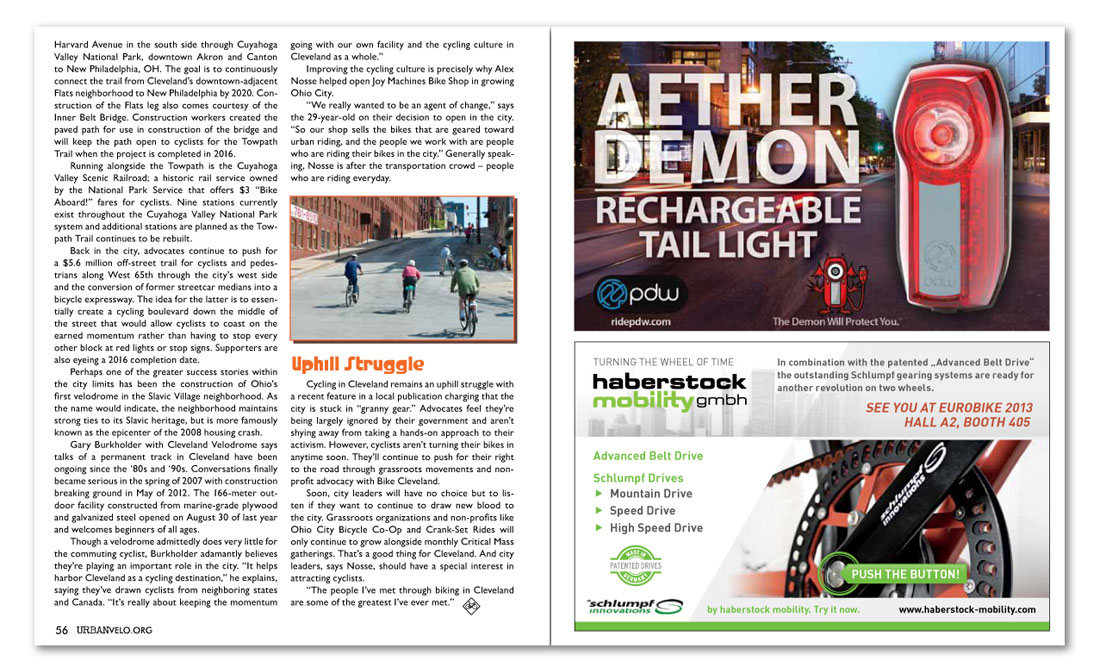


Harvard Avenue in the south side through Cuyahoga Valley National Park, downtown Akron and Canton to New Philadelphia, OH. The goal is to continuously connect the trail from Cleveland’s downtown-adjacent Flats neighborhood to New Philadelphia by 2020. Construction of the Flats leg also comes courtesy of the Inner Belt Bridge. Construction workers created the paved path for use in construction of the bridge and will keep the path open to cyclists for the Towpath Trail when the project is completed in 2016.
Running alongside the Towpath is the Cuyahoga Valley Scenic Railroad; a historic rail service owned by the National Park Service that offers $3 “Bike Aboard!” fares for cyclists. Nine stations currently exist throughout the Cuyahoga Valley National Park system and additional stations are planned as the Towpath Trail continues to be rebuilt.
Back in the city, advocates continue to push for a $5.6 million off-street trail for cyclists and pedestrians along West 65th through the city’s west side and the conversion of former streetcar medians into a bicycle expressway. The idea for the latter is to essentially create a cycling boulevard down the middle of the street that would allow cyclists to coast on the earned momentum rather than having to stop every other block at red lights or stop signs. Supporters are also eyeing a 2016 completion date.
Perhaps one of the greater success stories within the city limits has been the construction of Ohio’s first velodrome in the Slavic Village neighborhood. As the name would indicate, the neighborhood maintains strong ties to its Slavic heritage, but is more famously known as the epicenter of the 2008 housing crash.
Gary Burkholder with Cleveland Velodrome says talks of a permanent track in Cleveland have been ongoing since the ‘80s and ‘90s. Conversations finally became serious in the spring of 2007 with construction breaking ground in May of 2012. The 166-meter outdoor facility constructed from marine-grade plywood and galvanized steel opened on August 30 of last year and welcomes beginners of all ages.
Though a velodrome admittedly does very little for the commuting cyclist, Burkholder adamantly believes they’re playing an important role in the city. “It helps harbor Cleveland as a cycling destination,” he explains, saying they’ve drawn cyclists from neighboring states and Canada. “It’s really about keeping the momentum going with our own facility and the cycling culture in Cleveland as a whole.”
Improving the cycling culture is precisely why Alex Nosse helped open Joy Machines Bike Shop in growing Ohio City.
“We really wanted to be an agent of change,” says the 29-year-old on their decision to open in the city. “So our shop sells the bikes that are geared toward urban riding, and the people we work with are people who are riding their bikes in the city.” Generally speaking, Nosse is after the transportation crowd – people who are riding everyday.
Uphill Struggle
Cycling in Cleveland remains an uphill struggle with a recent feature in a local publication charging that the city is stuck in “granny gear.” Advocates feel they’re being largely ignored by their government and aren’t shying away from taking a hands-on approach to their activism. However, cyclists aren’t turning their bikes in anytime soon. They’ll continue to push for their right to the road through grassroots movements and non-profit advocacy with Bike Cleveland.
Soon, city leaders will have no choice but to listen if they want to continue to draw new blood to the city. Grassroots organizations and non-profits like Ohio City Bicycle Co-Op and Crank-Set Rides will only continue to grow alongside monthly Critical Mass gatherings. That’s a good thing for Cleveland. And city leaders, says Nosse, should have a special interest in attracting cyclists.
“The people I’ve met through biking in Cleveland are some of the greatest I’ve ever met.”